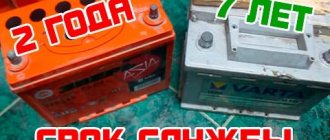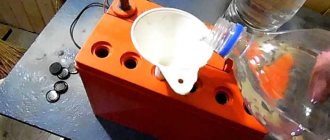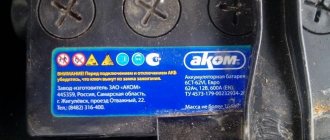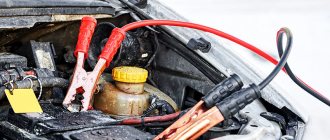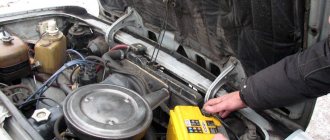A modern car cannot be operated without a mobile source of electricity. The battery not only allows you to start the car engine, but also takes on the main load at low generator speeds.
There are 2 main types of batteries: serviced and maintenance-free. What a maintenance-free chemical source of electricity is will be discussed in detail in this article.
What is a maintenance free battery
A maintenance-free battery is a product in which there is no possibility of topping up with distilled water. Such devices are safer during operation and charging, due to the reduction in the release of explosive gas, as well as the spillage of acid solution when tipped over.
As for the internal filling, a maintenance-free battery is no different from a serviced one. You can visually determine whether a battery belongs to the category of maintenance-free products by the absence of filler plugs.
Structure of a maintenance-free battery
Actually, it is not much different from its brothers “in the shop”, namely:
- Sealed housing . Which “ALMOST” has no connection with outside air. Why almost? Yes, because there is a special system of “labyrinth channels” where steam enters, which can be formed when charging a battery, as well as from heating and condenses back. HOWEVER, there are one (or two) special valves (usually located in the lid of these labyrinths) that relieve pressure in the event of overcharging. This is important to note - sooner or later they will lose most of the distilled water that is part of the electrolyte
- These are 6 packages of plates - which consist of positive and negative elements. It is in them that the whole “solution” to a maintenance-free battery lies. Typically, calcium or even silver additives are used in both positive and negative plates (or possibly both). This combination practically eliminates the process of electrolysis (boiling of the electrolyte during charging); accordingly, the evaporation of gases is minimal, that is, there is no such high pressure in the banks, and therefore they can be made maintenance-free (protected by pressure relief valves in case of failure of the generator or regulator relay when it will begin to recharge).
- At the top you can see two current terminals . They are usually made from thick cylindrical lead, made to standards to fit a large number of vehicle terminals
As you can see, nothing supernatural, an ordinary acid battery. However, I would like to note that the presence of calcium and silver in the structure reduces internal resistance and increases current output, which is really good.
Which one to choose, serviced or unserviced
Deciding on the type of battery to purchase can be very difficult. If the car previously had a serviceable battery installed, many car owners prefer not to change their habits. Serviced batteries have the following advantages:
- It is possible to check the electrolyte level and its density.
- If the level is insufficient, you can easily restore the battery’s functionality by adding the required amount of distilled water.
Unfortunately, this type of battery also has many disadvantages:
- Evaporation of water in hot weather and when the battery is overcharged.
- If you roll over on your side or drive too vigorously off-road, an electrolyte spill may occur.
- Higher leakage current, especially if electrolyte was spilled on the upper outer plane, between the terminals, during refueling.
- Additional time costs for preventive inspection and maintenance.
Serviceable battery
The maintenance-free battery has the following positive characteristics:
- Set it and forget it;
- No need to add water.
- If the battery fails, it will not be possible to restore its functionality.
- If the electrolyte boils away, it will not be possible to add distilled water without rough mechanical intervention;
- Critical to overcharging and deep discharges.
Attention! If your car has serious electrical problems, a maintenance-free battery will not last long. In this case, it is better to purchase a serviced battery and carefully monitor the quality and level of electrolyte.
If there are no abnormalities in the vehicle’s on-board electrical network, then the most correct decision would be to purchase a maintenance-free device.
What is it and which is better?
The idea of a maintenance-free battery appeared with the entry into the market of automotive calcium batteries. In these products, the positive and negative electrode arrays are made of a lead-calcium alloy.
In the serviced batteries used previously, the lead plates had the addition of antimony. Antimony was added to strengthen the lead and at the same time it was a catalyst for the hydrolysis of water in the electrolyte. This reaction is essentially the decomposition of water into hydrogen and oxygen under the influence of an electric current. And it looks like evaporation. That is why the expression “boiling away” of water from the electrolyte appeared.
Manufacturers began to use calcium instead of antimony, and this decision turned out to be very successful. With the advent of such batteries, there was no need to add water.
Maintenance-free battery - what is it? - this is a sealed battery , without direct access to banks and plates, (most often calcium or hybrid).
Due to low self-discharge, all maintenance-free starter batteries are factory filled with electrolyte and sealed. The technology of such batteries requires long-term storage in a charged state.
In any case, you should sometimes check its voltage level; its value should be at least 12.5 volts. If the voltage is lower than indicated, the battery should be recharged. Manufacturers stipulate that this will have to be done no more than once every six months, and with hybrid grids the period between charges increases to one and a half years.
Of course, batteries should be stored in a cool, dry place with temperatures up to +16 degrees. Therefore, a battery that was manufactured 12 months ago and has undergone one charging cycle can also be successfully stored for a second year.
What types of maintenance-free batteries are there?
If you decide to purchase a maintenance-free battery, then you need to know that these devices differ not only in capacity and discharge current.
Lead calcium battery
A maintenance-free battery can be of the following types:
- Calcium lead acid. The plates of this type of device are alloyed with calcium, as a result of which the material acquires properties such as vibration resistance and reduced corrosion effect. Also in calcium batteries there is a decrease in the process of self-discharge and boiling of the electrolyte.
- A.G.M. It is an acid battery in which the electrolyte is contained in special fiberglass separators between the plates. This type of maintenance-free battery can withstand deep discharges more easily, and by reducing the intensity of sulfation of the plates, the service life can be increased to 10 years.
- EFB. The design features of this type of battery are that the thickness of lead batteries is significantly increased compared to conventional products. To reduce sulfation, each plate is wrapped in a special material, which is impregnated with an acidic electrolyte. Thanks to the use of modern technologies, the service life of an EFB battery ranges from 5 to 10 years.
- GEL.
Unlike other batteries, these have helium inside.
The above types of maintenance-free batteries will work without any complaints only with properly organized recharging, when the battery capacity drops below the established minimum limit for starting the engine.
Where to choose
Now the motorist must find the answer to the question of which battery will be better - serviced or maintenance-free.
It is important to note that now the vast majority of batteries are produced in a sealed case. According to some estimates, this is approximately 80–85% of the total number of batteries sold.
This alone makes it clear in many ways which option is better when a serviced and maintenance-free type of battery is offered.
Statistics, comparisons and reviews from motorists suggest that maintenance-free batteries are more preferable. This can be explained by several reasons:
- minimal intervention in the design;
- sealed and therefore safer housing;
- the ability to turn the case over without fear of spilling electrolyte;
- convenient charge indicator in the form of a viewing eye;
- increased service life;
- more modern and advanced technologies.
Based on which battery will be best for you specifically, you will make the appropriate decision when choosing batteries. Nowadays, a serviceable battery is losing its position, since its maintenance-free counterpart has a large number of advantages. Modern batteries are manufactured on the basis of new technologies, and among them there are no serviceable ones.
Which chargers can charge maintenance-free batteries?
Considering the confined space in which the battery plates of a maintenance-free type are located, it is necessary to prevent significant overcharging of the battery.
Attention! To prevent the device from boiling, it is recommended to use an automatic charger.
The main advantage of this type of charger is the lack of human control during the entire charging time of the battery. The “smart” device itself will decide what voltage and current to apply to the battery terminals at the beginning of charging, in the middle of the cycle and at the last stage.
In the absence of an automatic device, you can restore the capacity with a conventional charger, but in this case, you will need to fully control the process.
For calcium batteries, you can use any standard charger; for gel and AGM batteries, a special charger is required.
EFB battery
What tools are needed for opening
To gain access to the filler holes, even if they are filled at the factory to the surface level of the case, you must remove the cover from the battery. How to open the battery cover? If it is on the grooves, then carefully unclip the fasteners and remove the element. You may need a flathead screwdriver.
A hot pressed part will not come off easily. During its dismantling, there is a high probability of the part breaking. Therefore, we do not recommend removing this type of element. However, if you wish, you can try to break the integrity of the part using an awl, screwdriver or drill. You will not remove the cover completely, but you will be able to make holes for further operations.
How to charge a maintenance-free battery
Before charging a maintenance-free battery with a conventional charger, it is necessary to correctly determine the battery discharge level. Considering the fact that it is not possible to open such a battery to check the electrolyte level and its density, the degree of discharge is measured using multimedia. Many batteries are also equipped with a charge indicator.
This device allows you to measure DC voltage with an accuracy of hundredths of a volt. If during diagnostics the voltage at the terminals is more than 12.6 V, then there is no need to charge the battery. If the voltage drops to 12 V, the battery charge will be only 50%, and if the voltage is less than 11.7 V, the battery is considered completely discharged.
The charging time when the battery is completely discharged is easy to calculate. The recommended charge current for all car batteries is 10% of the battery capacity. For example, if you need to restore a completely discharged battery with a capacity of 60 A/h, you will need to turn on the charger for 10 hours, and the charge current should be 6 amperes.
It is easy to calculate how much time will be required when the discharge is 50% or when the battery capacity is reduced by 30%. To do this, you need to divide the total battery capacity by 100 and multiply by the charge reduction percentage, then divide the resulting result by 6 for a 60 A/h battery and by 5.5 for a 55 A/h battery.
Do I need to add water or electrolyte?
A new, maintenance-free battery that works properly in your vehicle does not need to be opened or serviced.
If it was subjected to a long recharge, turned over, or its performance dropped sharply - only then you need to think about either purchasing a new battery, or how to disassemble and restore the faulty battery.
When to service your battery:
- If it is visible to the light that there is less electrolyte in one jar.
- The voltage at the terminals is low and charging has no effect.
- capacity noticeably decreased.
- Electrolyte leaked due to damage to the housing.
- Carrying out restoration after battery sulfation.
How to restore a maintenance-free battery
If a maintenance-free battery fails before the service life recommended by the manufacturer, then, in many cases, it is possible to restore the battery's performance to acceptable values. Considering the inability to disassemble a maintenance-free battery, you will have to pierce the top battery cover with an awl in 6 places. This way you can gain access to the electrolyte, which must be carefully drained from the battery.
At the next stage, distilled water is poured into the holes to the required level. Then the battery is charged until gas is released at a constant voltage of 14 V. When the charging process is completed, the battery is left for a while so that the lead plates are slightly cleared of the sulfate film.
After a few days, the battery charging procedure is repeated, after which the water is drained and a working mixture of sulfuric acid and water is added. After charging, the battery can be installed in the car. The holes in the top cover should be sealed with any acid-resistant sealant.
How to open the battery cover
Serviceable batteries have plugs for checking the cans. Getting to the contents of a maintenance-free battery is more difficult. There are no plugs, and the monolithic lid is a labyrinth for trapping and condensing vapors. Disruption of the labyrinth's passages will reduce the efficiency of the system. Therefore, before opening the battery cover, you need to weigh the pros and cons.
Attention! Before opening and checking the battery, it must be charged! The density of the electrolyte on a discharged battery is significantly lower!
Here are some options for how to get to the electrolyte:
What is a maintenance free battery?
The concept of a maintenance-free battery has come into use since the advent of Ca/Ca car batteries. In such models, positive and negative electrode arrays are made from an alloy of lead and calcium. The so-called serviced models that were produced before had grilles made of an alloy of lead and antimony. Old car batteries had a high antimony content and very high water consumption. Now they are no longer produced, and they have been replaced by models with a lower antimony content. They are also called low-antimony. The antimony content in the plates is less than 6 percent. In them, monitoring the electrolyte level must be periodic, since distilled water is constantly leaving it. Why? To do this, you need to consider the processes occurring in the battery.
When the battery is discharged, lead dioxide is reduced inside the car battery at the anode with sulfuric acid. At the same time, lead oxidation occurs at the cathode. When charging a battery, the process goes in the opposite direction. Antimony was added to lead plates in order to improve their strength characteristics. It is not possible to use electrodes made of pure lead due to its low strength. But the addition of antimony also brings a problem. Antimony acts as a catalyst for the hydrolysis of water from the electrolyte. Hydrolysis is the decomposition of water into hydrogen and oxygen under the influence of electric current. Outwardly it looks like boiling. That is why such an expression as “boiling away” of water from an electrolyte arose.
To solve this problem, manufacturers began to add calcium to electrode grids. This solution turned out to be very successful in terms of reducing water consumption.
With the advent of calcium-type car batteries, the concept of maintenance-free batteries appeared. And the lack of need for maintenance only concerns adding water to the battery.
Models without openings for access to banks began to appear in the product lines of battery manufacturers. To check the state of charge of the battery on such batteries you can often find a hydrometer or “peephole”. The hydrometer is designed to monitor the battery charge level. In the images below you can see a maintenance-free and a maintenance-free battery.
We also recommend reading the article about battery labeling.
Hybrid car battery
It is worth noting another category of maintenance-free batteries – gel batteries. In gel batteries, the electrolyte is in a bound state. This may be an impregnation of fiberglass or a gel-like state. In most cases, such models are made in maintenance-free housings and do not require topping up water. Although in some cases distilled water is added to AGM batteries. For example, when restoring gel batteries.
How is it different from serviced batteries?
Actually, they differ in a slightly different plate structure, yet even hybrid batteries sometimes do not reach the characteristics of calcium ones. And an ALMOST sealed case, unattended, with an often locked atmosphere inside. NO TRAFFIC TRAFFIC HERE! And the state of the electrolyte is controlled by the so-called “green eye”
Serviced batteries often have plugs on top for unscrewing and viewing the “cans” inside. That is, you can physically look inside, see the level and condition of the electrolyte ( is it cloudy ), measure its density, inspect the plates for shedding and sulfation .
YES, the structure of the batteries being serviced is different, they have slightly different additives in the plates - for example, in antimony (old versions) only antimony , but it begins to boil when charging already at 12.5 V, so you can’t close the cans, they will simply burst. In hybrids there is a combination of calcium and antimony , calcium + antimony + silver, etc. As a rule, they are also not closed, but stoppers are made for each jar, yet again there is the option of boiling!
I think we figured it out, roughly speaking: no traffic jams - unattended, there are traffic jams - serviced
However, it turns out that with all the advantages of the (“cork-free” option), there are also a large number of disadvantages of these types of batteries.
Maintenance of maintenance-free batteries
Despite their name, maintenance-free batteries still require maintenance. Moreover, in some cases, maintenance-free performance, as they say, “backfires.”
Below are the main disadvantages of maintenance-free car batteries:
- It is difficult to control the electrolyte level;
- It is impossible to control the density of the electrolyte;
- They require flawless operation of the vehicle's electrical network and stability of the output characteristics.
As for the electrolyte level, some models of maintenance-free car batteries have minimum and maximum marks. For more information about what battery acid is, read the article at the link.
Markers for checking electrolyte level
In this case, the task of monitoring the electrolyte level is simplified. But on the other hand, what does knowing your electrolyte level give you? What if it is less than necessary? Still can't top it up. Of course, the water consumption is insignificant. And the covers of maintenance-free batteries are specially designed to ensure electrolyte recirculation. But distilled water still leaves, but you can’t top it up. And if the level drops to the point where the plates are exposed, then the life of the battery will begin to rapidly decrease. If you use the battery like this, then very soon the car battery will need to be repaired or it will go to the landfill.
Another problem with maintenance-free car batteries is the inability to measure the density of the electrolyte. And this characteristic is very important and gives an objective assessment of the condition of the battery.
At least just measure the density after the battery charging process for control. After all, without this, it is extremely difficult to understand the degree of charge and voltage here cannot be an objective indicator. To assess the state of charge of the battery, manufacturers build a hydrometer into maintenance-free car batteries. Car enthusiasts often call it the “peephole”.
Safety precautions
- We strongly recommend using protective equipment when disassembling the power supply. It is strictly forbidden to turn over or shake the jars. This may cause a short circuit.
- If the battery cover is secured with fasteners, be careful not to break them. In the event of a breakdown, the part will have to be glued, and this does not guarantee safe operation of the power source.
- If you want to split the battery using a tool, choose special products that will help protect your eyes from splinters.
Can we safely say that a maintenance-free battery can be made into a serviceable one? Of course, a closed battery can be remade! If the purpose of opening the battery is to extract lead for fishing or hunting, then by observing a number of precautions, you can easily do it with just a hammer.
How to charge a maintenance-free battery?
In the vast majority of cars, the voltage regulator in the on-board network sets a limit of 14.4-14.8 volts. The choice of this value is not accidental, since at large values active hydrolysis of water begins and its consumption increases. When charging from a mains charger, you should also avoid exceeding the voltage above this value. In practice, you need to keep the battery voltage no more than 15.5 volts. More information about car battery voltage can be found in the article at the link.
As for the charger, it is better to use an automatically controlled charger to charge a maintenance-free battery. Then the charging process is ensured by special software embedded in the charger. In this case, commands to change current or voltage will be given by an algorithm, focusing on the electrical characteristics of the battery.
All you have to do is connect the charger “crocodiles” to the battery terminals, observing the polarity, and plug the device into the network. Additionally, you can read about what straight battery polarity is.
Charging a car battery
Do not forget that when charging a battery, chemical reactions occur and harmful substances are released. Therefore, the battery should be charged in a well-ventilated area.
If you use a charger with manual adjustment of current and voltage, we recommend that you adhere to the following charging scheme for a maintenance-free battery. After connecting the charger to the battery, set the current to 0.1 of the battery capacity. That is, with a capacity of 55 Ah, this value will be 5.5 amperes. After this, set the voltage to 14.5 volts and turn on the charger. Learn more about what an ampere hour is.
Monitor the parameters during charging. The voltage will gradually increase during charging, and the current will decrease. When the battery voltage rises to 14.4 volts, the current should decrease to approximately 200 mA, which corresponds to the self-discharge current of the battery. The charging process will be completed.
Here it is worth making a reservation about charging the battery after a deep discharge. In this case, the charging process should begin with a current of 1-2 amperes. It is better to set the charging voltage to somewhere around 12-13 volts, and keep the current during charging to no more than 5 percent of the nominal capacity of the battery. Read more about how to properly charge a car battery with a charger.
In the table below you can see the relationship between the state of charge of a car battery and the density of the electrolyte. The freezing temperature of the electrolyte at different densities is also given. We also recommend reading about how to charge a gel battery.
| Electrolyte density, g/cm. cube (+15 degrees Celsius) | Voltage, V (no load) | Voltage, V (with load 100 A) | Battery charge level, % | Electrolyte freezing temperature, gr. Celsius |
| Electrolyte density, g/cm. cube (+15 degrees Celsius) | Voltage, V (no load) | Voltage, V (with load 100 A) | Battery charge level, % | Electrolyte freezing temperature, gr. Celsius |
| 1,11 | 11,7 | 8,4 | -7 | |
| 1,12 | 11,76 | 8,54 | 6 | -8 |
| 1,13 | 11,82 | 8,68 | 12,56 | -9 |
| 1,14 | 11,88 | 8,84 | 19 | -11 |
| 1,15 | 11,94 | 9 | 25 | -13 |
| 1,16 | 12 | 9,14 | 31 | -14 |
| 1,17 | 12,06 | 9,3 | 37,5 | -16 |
| 1,18 | 12,12 | 9,46 | 44 | -18 |
| 1,19 | 12,18 | 9,6 | 50 | -24 |
| 1,2 | 12,24 | 9,74 | 56 | -27 |
| 1,21 | 12,3 | 9,9 | 62,5 | -32 |
| 1,22 | 12,36 | 10,06 | 69 | -37 |
| 1,23 | 12,42 | 10,2 | 75 | -42 |
| 1,24 | 12,48 | 10,34 | 81 | -46 |
| 1,25 | 12,54 | 10,5 | 87,5 | -50 |
| 1,26 | 12,6 | 10,66 | 94 | -55 |
| 1,27 | 12,66 | 10,8 | 100 | -60 |
Deep discharges
You know, no matter what anyone says, but a maintenance-free calcium battery is afraid of deep discharges (this is another disadvantage). Although now, again, some batteries have the inscription “resistant to deep discharges,” but it seems to me that it is necessary to clarify how many of them it can survive.
Previously, I wrote that literally 5 - 7 deep discharges can remove up to half the battery capacity - I STILL THINK SO! Even if silver is added to the formula, the battery can survive 10 discharges, but the capacity will definitely drop after such abuse. Therefore, it is unacceptable to allow such critical discharges. Because this is critical.
Why are we watching an interesting video now?
I’ll finish with this, you can take a maintenance-free battery, but you need to carefully check the electrics of your car for faults, so that later it won’t be excruciatingly painful for a ruined battery. I’ll end here, sincerely yours AUTOBLOGGER
Similar news
- Deep battery discharge. What it is? And also the reasons and...
- Normal car battery voltage. Under load and...
- How to check battery charge with a multimeter. Let's find out the evidence...
Add a comment Cancel reply
Let's sum it up
So, you have become the owner of a maintenance-free battery. But it still needs to be serviced. How to do this and what to pay attention to. Below are some recommendations:
- Do not use the battery if the on-board voltage is outside the range of 13.9-14.4 volts;
- Monitor the operation of the generator, voltage relay regulator;
- It is necessary to maintain all elements of the car’s on-board network in good condition so that there are no current leaks;
- Periodically recharge the maintenance-free battery as described above;
- If the battery is in storage, keep it in a cool place if possible to reduce self-discharge and loss of capacity.
As you can see, with maintenance-free batteries, not everything is so simple. On the one hand, such batteries really do not require topping up with distilled water, but otherwise they require maintenance. They need to be periodically charged from a network charger, kept clean, and monitored for serviceability of the on-board network of the car in which the battery is used.
Summarizing all that has been said, we can conclude that maintenance-free batteries are suitable for use in foreign cars of the mid-price range with a standard set of options. In this class of car, serviceable electrical equipment and the battery will function under normal conditions. If your car is old enough, worn out, and voltage surges in the on-board network are possible, then it is better to take a regular, low-antimony, serviceable car battery.
Characteristics
A closed, sealed case is what distinguishes a serviceable battery from a maintenance-free one. The structure of such batteries is as follows:
- Negatively and positively charged lattice lead plates.
- Jars are separate containers with plates contained in them.
- Electrolyte.
- A housing with terminals, usually without plugs, but with inspection eyes.
The lattice structure is saturated with electrolyte and creates a chemical reaction. To separate the charged electrodes, a separator is installed inside the housing.
The battery case is made of durable material to ensure the integrity of the internal structure and is resistant to chemical influences.
One of the criteria when purchasing a battery is the duration of its use. The guaranteed operation of maintenance-free starting batteries is 5-6 years.
To use this product correctly, you must meet certain conditions:
- Charge the battery strictly according to the instructions. Maintenance-free batteries are sensitive to voltage fluctuations. When charging, it should not exceed 14.5 volts.
- Have the vehicle's on-board instruments working properly.
- Take into account temperature changes. In severe frosts, it is advisable to remove the battery, since if the charge is low, the electrolyte can freeze and cause the cans to swell.
- Consider the characteristics of your type of riding.
Important! When traveling around the city, the battery may not have time to recharge from the generator. Accordingly, in such cases you need to choose a battery with increased capacity.
Charging process
The battery should be charged periodically using a special charger. Most cars have an on-board voltage of about 14.4 V. This value was chosen because too high a voltage speeds up the process of water evaporation. When charging from a network device, you must maintain a voltage level of no higher than 15.5 V. Features of the charging process:
- When choosing a charger, you should give preference to models that have an automatic control unit. The charging process in this case eliminates the possibility of damage to the battery.
- Commands to change current and voltage are given by the electrical unit of the charger.
- In the process of replenishing the charge level, chemical reactions take place, leading to the release of harmful substances. That is why it is recommended to carry out the charging process in a well-ventilated area. Too high a concentration of gases released can be harmful.
Such chargers are expensive . This is why chargers with a manual control unit are often found in garages:
Types of batteries
There are the following types of car batteries:
- serviced;
- poorly maintained;
- hybrid;
- not serviced.
Serviced. This type of car battery is almost out of service and is extremely rare in retail sales. Typically, these are models from domestic manufacturers. They are distinguished from other types of batteries (especially foreign ones) by a large number of disadvantages that affect ease of use.
The disadvantages of serviced batteries include a fragile, unprotected case (most often made of ebonite), which was coated for insulation with a special substance that loses its properties with sharp fluctuations in ambient temperature. This is the reason for the sharp drop in battery charge in winter. This was also the reason for the drop in the liquid level in the containers, which required its constant replenishment.
- Low maintenance. Most often found in modern cars. Typically, such batteries are characterized by a very durable casing made of various types of plastic. During operation, they require monitoring the level of electrolytic fluid and replenishing it approximately once every 30 thousand kilometers. The advantages include their fairly moderate cost.
- Hybrid. Hybrid car batteries are one of the modifications of the previous type of batteries. But they have a significant difference: the contact groups in the cells consist of different metals, which makes it possible to achieve certain advantages, namely:
- high current level during engine starting;
- low fluid consumption in the battery;
- long lifespan and unpretentiousness.
Hybrid car batteries are rare and not in great demand due to their high price.
Maintenance free. The design of such batteries does not provide for monitoring and restoring the water level in the cells, and therefore the necessary holes are missing on the body. However, for the correct use of maintenance-free car batteries, it is necessary to monitor other components and mechanisms of the car that are part of the electrical system
It is important to regularly monitor the condition of the belts, monitor the serviceability of the generator and all electrical wiring of the machine. The combination of convenience and low cost makes them an ideal choice for a car owner if he is confident in the technical condition of his iron horse
What can happen when opening the case?
If you open the battery case, this will lead to the fact that the water from the electrolyte will constantly evaporate and the battery will need to be refilled as if it were being serviced. Disassembling the battery in any way will void the warranty . For modern products, the manufacturer's warranty can range from 12 to 36 months.
Important! If the battery is under warranty, then before opening it and repairing it yourself, take it to a service center, maybe they can help you there.

